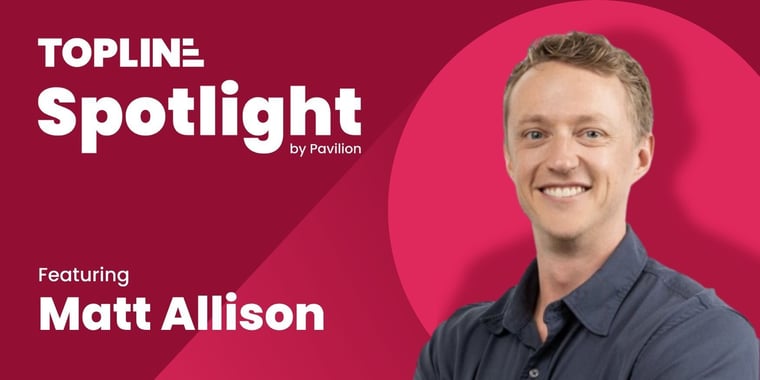When Matt Allison and AJ Bruno built TrendKite in 2012, they created a media intelligence platform that transformed how brands understood their press coverage. Seven years and a nine-figure exit later, Matt's back with Handraise—and he's not just iterating on his previous success. He's completely reimagining it.
As founders rush to bolt AI onto existing workflows, Matt is doing the opposite: starting with enterprise pain, and letting AI shape the solution.
The difference? AI has changed everything.
"Our product today is dramatically more sophisticated at this stage than our TrendKite product was after seven years," Matt explains. This isn't just founder hyperbole. It's the reality of building in the age of AI.
But Matt's biggest challenge isn't technical. It's strategic: How do you build an enterprise-focused product from day one when conventional startup wisdom pushes you toward quick, small deals to show traction?
Let's unpack the lessons every founder should learn from Handraise's approach.
The Enterprise-First Gamble
Most startups follow a predictable path: start with small customers, move upmarket over time. TrendKite did exactly this. Their first-year deals averaged $2,000-$5,000. By exit, they'd climbed to $25,000.
But that journey taught Matt something crucial: small deals churn. Enterprise deals stick.
"Our tier five accounts, which were our $2,000-$5,000 ARR deals, had a very high rate of churn. Our tier one, which were $30K+, had best-in-class retention," Matt recalls.
This time, Handraise is flipping the script. They're targeting enterprise from day one—working with Walgreens, Hershey, and the Clooney Foundation rather than small agencies or startups.
It's a bold strategy that requires:
1. Patience to build a product sophisticated enough for enterprise needs
2. Stomach to delay revenue while perfecting that product
3. Investors who understand this approach won't produce hockey-stick growth overnight
The question every founder should ask: Are you building for the customers you want tomorrow, or the ones you can get today?
💡 Founder Tip: If you're pursuing enterprise early, build a roadmap that maps features to value signals, not MVP shortcuts. Be explicit with investors about your velocity vs. deal quality tradeoff.
When AI Makes Everything Better, Faster
The media intelligence space has always been labor-intensive. At TrendKite, enterprise clients required massive manual effort—exporting thousands of news articles to spreadsheets, cleaning data, building custom reports.
Handraise's AI approach changes the equation.
Their "narrative clusters" technology automatically groups news coverage into themes—giving execs a 30,000-foot view of how the world is talking about their brand.
"Historically, at TrendKite, that would've taken us many months to build, and it still wouldn't have been at the quality bar we're able to see today," Matt explains.
This isn't just about engineering efficiency. It's about margin transformation. Features that once required expensive human services can now be delivered as pure software.
💡 Ask Yourself: Where are you still delivering services with humans that could be transformed into software with AI?
The Enterprise Misunderstanding
There's a persistent myth in the VC community that media intelligence is just "a bunch of PR people running around pitching stories."
The reality? Enterprise communications teams are sophisticated operations that support business strategy, drive policy change, and manage complex narratives across global organizations.
"When you get into these organizations, they're large, sophisticated, complex communications that support the business," Matt explains.
This misunderstanding creates opportunity. While investors chase the next viral PLG tool, Handraise is building for customers with real budgets and complex problems.
The smartest founders bet on markets where perception and reality don’t align. The gap between what investors think a market is and what customers actually need often hides the biggest opportunities.
🔍 Founder Exercise: What markets do VCs dismiss that customers quietly rely on every day? List 3 industries where internal complexity outweighs external flash.
The AI Cost Equation
Building with AI creates new challenges. API calls cost money. Models change. Dependencies create risk.
Handraise's approach is instructive:
1. They've built a team with genuine AI expertise (not just marketing claims)
2. They optimize costs by pre-processing data before sending it to expensive models
3. They remain model-agnostic, continuously testing different options for performance
"We're not dependent on any singular model," Matt explains. "They're able to see which one is the most performant and then plug that in over time."
This approach maintains margins while avoiding platform risk—a balancing act every AI-powered startup must master.
The Patience Paradox
The hardest part of Handraise's strategy isn't technical. It's psychological.
"The problem we're trying to solve right now is: can we build a high-quality product in a short enough time window as a seed-stage company and get enough traction where it's meaningful to go raise the next round of financing?"
This is the central tension of modern entrepreneurship. Markets reward exponential growth. Enterprise sales cycles are linear. Building something meaningful takes time. Investors want results now.
Handraise's approach requires conviction—from founders and investors alike.
"Does the team have the stomach? Do the investors also have the stomach? Because we're not gonna see us go from zero to a million to 10 million to 100 million in less than a year."
The Takeaway: Think Bigger
The most revealing moment in Matt's story comes from his interaction with investor Mike Maples.
"If Handraise was gonna be a trillion-dollar business, what would that look like?"
Matt initially chuckled at the question. Then realized Maples was serious.
This mindset—thinking beyond incremental improvements to truly transformational outcomes—is what separates good companies from legendary ones.
AI gives founders superpowers. The question isn't whether you can build something better than what came before. That's table stakes. The real question is whether you can build something that was never possible before.
What would a trillion-dollar version of your startup do that your current version can’t? Write down 3 things and build backward.
That's the challenge Handraise has accepted. And it's the standard every founder should hold themselves to in the age of AI.
New episodes of Topline every Sunday and Thursday on Apple, Spotify, and YouTube.


